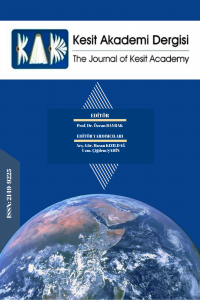REHABİLİTASYON SÜRECİNDE YETENEKLERİN ÖLÇÜMÜ
Yeteneklerin ölçümü rehabilitasyon değerlendirme sürecinin önemli bir parçasını oluşturmaktadır. Yeteneklerin ölçümü, rehabilitasyon sürecinin planlaması ve rehabilitasyon sonuçlarının değerlendirilmesi için bir temel sunmaktadır. Bu makalenin amacı, rehabilitasyon değerlendirmesi sürecince, yeteneklerin ölçümü ile ilgili kısa bir değerlendirme sunmaktır. Bu makale, güncel literatür kullanılarak, yeteneklerin ölçümünün tarihçesi ve yetenek ölçümünde kullanılan spesifik psikometrik ölçüm araçları ile ilgili bilgi vermektedir. Makalenin sonunda, bir özet ve yetenek ölçümü ile ilgili anahtar noktalar belirtilmiştir. Bu makalenin rehabilitasyon değerlendirme süreci ile ilgili daha fazla bilgi almak isteyen kişiler için giriş niteliğinde bilgi sunacağına inanılmaktadır.
Anahtar Kelimeler:
Değerlendirme, danışmanlık, psikoloji, rehabilitasyon
MEASUREMENT OF ABILITIES IN REHABILITATION PROCESS
Measurement of abilities is one of the main aspects of rehabilitation assessment. It provides a base to plan rehabilitation process and measure rehabilitation outcomes. The purpose of this article is to provide an overview of measurement of abilities in rehabilitation process. Using contemporary literature, this article discuss discuss history of measurement of abilities, and provide information regarding specific psychometric tools that are used to measure abilities. At the end, a summary and key points regarding the measurement of abilities is provided. It is believed that this article provides introductory information to those who aim to learn more about rehabilitation assessment process.
Keywords:
Measurement, counseling, psychology, rehabilitation,
___
- Anastasi, A. (1985). Psychological testing: Basic concepts and common misconceptions. In A. M. Rogers, C. Scheirer (Eds.), The G. Stanley Hall lecture series, (pp. 87-120). Washington, DC: American Psychological Association. doi:10.1037/10052-003
- Andrew, J. W. (1981). Evaluation of rehabilitation potential. In R. M. Parker & C. E. Hansen (Eds.), Rehabilitation counseling: Foundations-consumers-service delivery (pp. 205- 226). Bos- ton, MA: Allyn and Bacon
- Bellini, J. L., & Rumrill, P. D. (2009). Research in rehabilitation counseling: A guide to design, metho- dology, and utilization. Springfield, IL: Charles C Thomas Publisher.
- Berven, N. L. (1980). Psychometric assessment in rehabilitation. In B. Bolton & D. W. Cook (Eds.), Rehabilitation client assessment (pp. 46-64). Baltimore, MD: University Park Press.
- Berven, N. L. (2004). Assessment. In T. F. Riggar, D. Maki (Eds.), Handbook of rehabilitation counseling, (pp. 199-217). New York, NY: Springer.
- Boake, C. (2002). From the Binet–Simon to the Wechsler–Bellevue: Tracing theHistory of Intelli- gence Testing. Journal of Clinical & Experimental Neuropsychology, 24(3), 383.
- Canivez, G. L. (2010). Wechsler Adult Intelligence Scale-Fourth Edition. Retrieved from http://www.ux1.eiu.edu/~cfglc/Adobe%20pdf/Publications- Papers/Canivez%20%282010%29%20Buros%20MMY%20WAIS-IV%20Review.pdf
- Chan, F., Shaw, L. R., McMahon, B. T., Koch, L., & Strauser, D. (1997). A model for enhancing rehabilitation counselor–consumer working relationships. Rehabilitation Counseling Bul- letin, 41(2), 122-137.
- Cowger, C. D. (1994). Assessing client strengths: Clinical assessment for client empowerment. Social Work, 39(3), 262-268.
- Gardner, H., & Hatch, T. (1989). Multiple Intelligences Go to School: Educational Implications of the Theory of Multiple Intelligences. Educational Researcher, 18(8), 4-9.
- Gottfredson, L., & Saklofske, D. H. (2009). Intelligence: Foundations and Issues in Assessment. Canadian Psychology, 50(3), 183-195.
- Hepworth, D. H., Rooney, R. H., Rooney, G. D., Strom-Gottfriend, & Larsen, J. (2009). Direct social work practice: Theory and skills. Belmont, CA:Brooks/Cale
- Kaplan, R. M., & Saccuzzo, D. P. (2001). Psychological testing: Principles, applications, and issues (5th ed.). Belmont, CA: Wadsworth/Thomson Learning.
- Keith, T. Z., Kranzler, J. H., & Flanagan, D. P. (2001). What does the cognitive assessment sys- tem (CAS) measure? Joint confirmatory factor analysis of the CAS and the Woodcock- Johnson tests of cognitive ability (3rd edition). School Psychology Review, 30(1), 89-119.
- Lichtenberger, E. O., Volker, M. A., Kaufman, A. S., & Kaufman, N. L. (2006). Assessing gifted children with the Kaufman Assessment Battery for Children- Second edition (KABC-II). Gifted Education International, 21(29), 99-126.
- Maki, D. R, & Tarvydas, V. M. (2012). The professional practice of rehabilitation counseling. New York: Springer Pub.
- Naglieri, J. A., Goldstein, S., Conway, C., & Jansen, J. (2010). Intelligence. In E. Mpofu, T. Oak- land (Eds.), Assessment in rehabilitation and health, (pp. 225-241). Colombus, OH:Merrill
- Oakland, T., & Mpofu, E. (2010). Assessment in rehabilitation and health. Colombus, OH:Merrill.
- Robertson, I. T., & Kandola, R. S. (1982). Work sample tests: Validity, adverse impact and appli- cant reaction. Journal of Occupational Psychology, 55(3), 171-183.
- Stevenson, J. E., Kortte, K. B., Salorio, C. F., & Rohe, D. E. (2013). Assessment in rehabilitation psychology. In K. F. Geisinger, B. A. Bracken, J. F. Carlson, J. C. Hansen, N. R. Kuncel, S. P. Reise, M. C. Rodriguez (Eds.) APA handbook of testing and assessment in psychology: Testing and assessment in clinical and counseling psychology, (pp. 501-521). Washington, DC: American Psychological Association. doi:10.1037/14048-029
- World Health Organization (2010). Building bridges between diseases, disabilities, and assistive devi- ces. Retrieved from
- http://whqlibdoc.who.int/hq/ 2010/WHO _HSS_EHT_DIM_10.2_eng.pdf
- Başlangıç: 2015
- Yayıncı: Asos Eğitim Bilişim Danışmanlık San. Tic. Ltd. Şti.
Sayıdaki Diğer Makaleler
REHABİLİTASYON SÜRECİNDE YETENEKLERİN ÖLÇÜMÜ
TÜRKİYE-ALMANYA DIŞ TİCARETİNDE DÖVİZ KURU VE GELİR ETKİSİ: ARDL SINIR TESTİ YAKLAŞIMI
TÜRK KÜLTÜRÜNDE YER ALAN MİTOLOJİK SEMBOLLERİN VE MOTİFLERİN RAUF TUNCERİN ESERLERİNE YANSIMASI
OKUDUĞUNU ANLAMA BECERİSİNİN GELİŞTİRİLMESİNDE ETKİLEŞİMSEL OKUMA ÖĞRETİMİNİN ROLÜ
Tuncay TÜRKBEN, Fahri TEMİZYÜREK
“ŞEYH’İN OLDUĞU YER EVİMİZDİR”: İBRAHİM-İ GÜLŞENÎ’NİN HAGİOGRAFİSİNDE SÜRGÜN KAVRAMI
“A AY” VE “BAL” FİLMLERİNDE ÇOCUĞUN ÖLÜM KAVRAMINI NASIL ANLAMLANDIRDIĞI ÜZERİNE
GELİŞMEKTE OLAN EKONOMİLERDE KISA VADELİ SERMAYE HAREKETLERİNİN OPTİMİZASYONU
KIRSAL KALKINMADA ELEKTRONİK TİCARETİN ROLÜ ÜZERİNE TEORİK BİR İNCELEME
İlhami TUNCER, Mehmet Akif GÜNDÜZ
